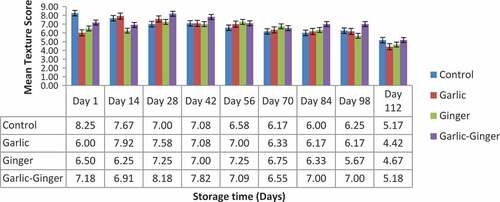ABSTRACT
Effect of packaging materials and spices on the sensory quality of smoked Clarias gariepinus (Burchell, 1822) was evaluated. The smoked C. gariepinus treated with garlic, ginger, garlic–ginger homogenate, and the control (unpreserved) was stored for 112 days at ambient temperature inside plastic (polyethylene terephthalate) and nylon (polythene). The four groups garlic, ginger, garlic–ginger homogenate spiced fish, and the control (unpreserved) fish samples comprising 216 fish in each group totaling 864 fish (226 ± 23 g) were euthanized, gutted, cleaned, and hot-smoked using Nigeria Institute for Oceanography and Marine Research (NIOMR) smoking kiln, packaged, and sampled at 14-day intervals for a period of 112 days at ambient temperatures (27 ± 2°C). Organoleptic assessment was carried out by a semi-trained taste panel. Data obtained were subjected descriptive statistics (mean) and virtual analysis (bar chart). The results indicated that garlic–ginger homogenate preserved catfish was rated as having the best odor (mean score 9.25) at the onset of the experiment, followed by ginger-preserved catfish (mean score 7.58). However, control was rated as having the best texture (mean score 8.25), followed by garlic–ginger homogenate (mean score 7.17). Plastic (polyethylene terephthalate) was established as a better packaging material than nylon (polythene) as the scores allotted by taste panelists started decreasing earlier for the odor and texture of the smoked fish samples with increased storage time when packaged inside nylon. Garlic–ginger homogenate was recommended as both preservative and spices of C. gariepinus, while plastic was recommended as better packaging material at room temperature.
Introduction
Fish is one of the most important foods on the planet. Its flesh is a source of high-quality protein, and for many, in less developed parts of the world, it represents a significant proportion of the animal protein in their diet. It is either taken as fresh fish or cured in a variety of ways such as smoking, salting, drying, charring, icing, and chilling.[Citation1] There is a global increase in the consumption of fish and fish products as it constitutes more than 60% of the total protein intake in adults especially in the rural areas where they are widely accepted and form a much-cherished delicacy that cuts across economic, age, religious, and educational barriers.[Citation2,Citation3] Some researchers reported that fish accounts for about one-fifth of the world’s total supply of animal protein sources. Fish supplies a good balance of protein, vitamins, and minerals with very low carbohydrate content, hence, its role in nutrition is recognized.[Citation4] However, fish is one of the perishable staples; it spoils very quickly because of intrinsic and extrinsic factors.[Citation5] A problem that has been identified in the storage of smoked fish in Nigeria is that of rapid deterioration as a result of high ambient temperatures, poor postharvest handling, lack of processing, and storage facilities, thereby creating the gap between the demand and supply of fish resulting in shortage of fish and posing great challenge to food security of the increasing population of the entire nation.[Citation6,Citation7] Some of the different types of preservation methods employed to reduce fish spoilage include drying, smoking, freezing, chilling, and brining. However, smoking has been used for fish preservation for centuries and is the most common fish preservation method employed in most rural communities in Nigeria.[Citation8,Citation9] Natural compounds in fruits and vegetables such as polyphenols such as flavonoids and tannins have shown to have preservative effects on fish and are often being used as food spices.[Citation10,Citation11] Some of the common natural spices mostly used in food preservation include garlic (Allium sativum Linn.), ginger (Zingiber officinale Roscoe), and lime (Citrus aurantifolia Linn.).[Citation11–Citation13] Food packaging serves the needs of marketing and also helps preservation of foodstuffs especially processed ones. It is one of the most important unit operations in the agro-processing industry as it performs the functions of protecting the product against external polluting agents, giving the product marketing value and providing the customer with information about ingredients or how to use the product.[Citation14] Survey carried out by many scientists in Nigeria shows that traditional packages and packaging of smoked fish products are generally not impermeable to moisture, insects, and microorganisms and also offer little protection from physical damage and microbial invasion which often lead to post harvest losses.[Citation13] Some of the recognized packaging materials in Nigeria include nylon (polyethylene), baskets, plastic (polyethylene terephthalate), jute bags, baskets and jute bags, cartons, etc.[Citation13,Citation15] Thus, the use of nylon (polyethylene) and plastic (polyethylene terephthalate) for this study due to their availability and affordability.[Citation16] Taste and smell play a major role in appetite, food choices, and nutrient intake for the following reasons; first, these chemosensory signals prepare the body to digest food by triggering salivary, gastric, pancreatic, and intestinal secretions which are termed cephalic phase responses; second, they enable us to detect and discriminate among foods in the face of fluctuating nutritional requirements; third, they enable selection of a nutritious diet as there exist associations between a food‘s taste (or smell) and its postingestive effects as taste enables the consumer to modulate food intake in the anticipation of its nutritional consequences. Thus, taste sensations serve as an indicator of a food‘s nutritional value. Fourth, taste and smell signals initiate, sustain, and terminate ingestion, and hence play a major role in the quantity of food that is eaten and the size of meals. Fifth, taste sensations induce the feelings of satiety and are the primary reinforcers of eating, thereby, justifying the use of texture, odor, and flavor (which is a combination of taste and odor) in determining the sensory quality of the differently packaged smoked Clarias gariepinus, which is the most cultivated fish species in Nigeria.
Materials and methods
Sample collection
Eight hundred and sixty four live catfish, C. gariepinus, with an average weight of 226 ± 23 g were collected by dragging with a drag net from an earthen pond at Ire Akari fish farm, Omi-Adio, Ibadan Oyo State Nigeria and conveyed using plastic bowls within 43 min to the fish processing unit of the Federal College of Animal Health and Production Technology (FCAH&PT), Moor Plantation Ibadan. Fish collection was carried out between 07.00 and 09.00 am to reduce stress. Six kilogram each of dried garlic A. sativum bulb and ginger Z. officinale rhizome were bought at Bodija market in Ibadan Oyo state Nigeria, transported to the fish processing laboratory of FCAH&PT and ground into powder using sterile explosion proof waring blender (New Hartford, CT). Samples from powdered A. sativum and Z. officinale were also collected and homogenized manually in a ratio 1:1 to give garlic–ginger homogenate. Two hundred and eighty eight transparent plastic (polyethylene terephthalate) and transparent zip-lock nylon bags (polythene) were purchased from Alesinloye market in Ibadan Oyo state Nigeria, while 12 plastic baskets were also purchased to store the unpackaged fish products.
Experimental site
The experimental site was the Department of Fisheries Technology of the FCAH&PT, Moor Plantation Ibadan where the NIOMR smoking kiln was used for the study.
Processing of fish samples
Fish samples were euthanized[Citation17] by adding 20 g table salt/kg fish in plastic container for 10 min, gutted, eviscerated, washed in portable water, immersed in 15% brine for 5 min[Citation18] then divided into four groups comprising 216 pieces each.
Treatment of fish samples with preservatives
No preservative was added to the first group of fish (control), while the remaining three groups were treated with garlic, ginger, and garlic–ginger homogenate at ratio 1:20 g for preservative fish after which they were smoked. Seventy-two samples of each treated smoked catfish were then packaged in nylon (polythene) and plastic (polyethylene terephthalate), while others were left unpackaged at ambient temperatures (25–36°C). The samples were stored for 112 days and sampled at 14-day intervals for organoleptic quality. The fish were euthanized, spiced, and packaged following the procedure of Ref. [Citation9].
Treatments and experimental design
The experimental design was a 4 × 3 × 9 factorial experiment comprising of the following factors:
A—Four treatments (1) Co—no preservatives (control), (2) garlic—A. sativum (GA), (3) ginger—Z. officinale (GI), and (4) mixture of GA and GI (GG);
B—Three packaging materials (1) no packaging, (2) polythene (nylon), and (3) polyethylene terephthalate (plastic); and
C—Nine different storage time (1) 1 day, (2) 14 days, (3) 24 days, (4) 42 days, (5) 56 days, (6) 70 days, (7) 84 days, (8) 98 days, and (9) 112 days.
Organoleptic assessment
Smoked fish samples stored at ambient temperatures were collected for organoleptic assessment at every 14-day intervals for 112 days. The sensory quality attributes evaluated were based on a 5-point hedonic scale from the modified methods of Refs. [Citation19,Citation20]. The parameters examined were odor, flavor, and texture; and the following grades were allotted: 8 ≤ 10 = excellent, 6 ≤ 8 = very good, 4 ≤ 6 = good, 2 ≤ 4 = bad, and ≤2 = very bad. Twelve semi-trained panelists from the FCAH&PT, Ibadan were used for the assessment.
Statistical analysis
The data were subjected to descriptive statistics (mean) and virtual analysis (bar chart) of the respondents’ rating of the products in terms of odor, flavor, and texture (preservatives) by the different packaging materials (no packaging, nylon, and plastics).
Results
The result of the effect of different preservatives on the odor of unpackaged smoked catfish stored at ambient temperatures as presented in indicates that garlic–ginger homogenate preserved catfish was rated as having the best odor immediately after smoking (with mean score of 9.25), followed by ginger-preserved catfish (with mean score of 7.58). Similarly, trend was observed on the 28th, 42th, 56th, 70th, 84th, and 98th days of storage at ambient where the odor of garlic–ginger homogenate preserved catfish rated as the best with the mean score 8.08, 7.50, 7.42, 7.17, 6.92, and 7.08, respectively. However, ginger was rated to have the best odor when stored at ambient on the 112 day of storage. The result also indicates that the scores allotted by taste panelists for the odor of smoked fish samples started reducing from the 56th day of storage at ambient through 112 days when no packaging was used with the exception of garlic–ginger homogenate preserved smoked catfish whose allotted scores started reducing after the 98th day of storage at ambient.
Figure 1. Effect of different preservatives on the odor of unpackaged smoked catfish stored at ambient temperatures

Similarly, the result in indicates that the taste panelist ranked the catfish preserved with garlic–ginger as having the best odor on the 1st, 14th, 28th, 56th, 70th, 84th, and 98th days of storage with mean scores 9.25, 8.17, 7.58, 6.75, 7.17, 7.08, and 6.50, respectively. Ginger-preserved smoked catfish was however rated as having the odor when packaged inside nylon on the 42nd day of storage with mean score 7.25. The result also indicates that the scores allotted by taste panelists for the odor of smoked fish samples started reducing after the 70th day through 112 days of storage when nylon was used as packaging material.
Figure 2. Effect of polythene as packaging materials on the odor of differently preserved smoked catfish stored at ambient temperatures
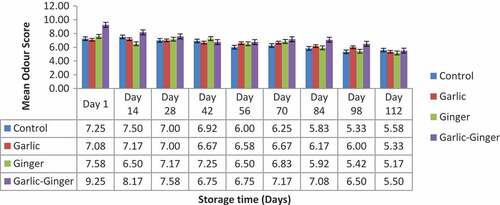
The result on also indicates that garlic–ginger homogenate preserved catfish was rated to have the best odor throughout the period of storage when packaged inside plastic (polyethylene terephthalate) with the mean score of 9.27, 7.82, 8.09, 7.45, 7.73, 7.82, 7.09, 6.82, and 6.00 on the 1st, 14th, 28th, 42nd, 56th, 70th, 84th, 98th, and 112th days of storage, respectively. The result also indicates that the scores allotted by taste panelists for the odor of smoked fish samples started reducing after the 70th day through 112 days of storage when plastic was used as packaging material.
Figure 3. Effect of polyethylene terephthalate as packaging materials on the odor of differently preserved smoked catfish stored at ambient temperatures
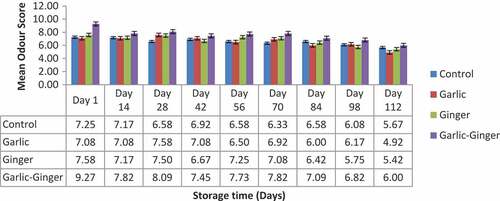
The result of the effect of different preservatives on the flavor of unpackaged smoked catfish stored at ambient temperatures as presented in indicates that the flavor of unpreserved smoked catfish was rated as the best immediately after smoking (with mean score of 9.00), followed by garlic–ginger homogenate preserved catfish (with mean score of 8.59). However, garlic–ginger homogenate preserved catfish was rated as having the best flavor on the 14th, 28th, 42nd, 84th, and 98th days of storage with mean scores 8.50, 8.50, 7.33, 7.08, and 6.58, respectively. The result also indicates that the scores allotted by taste panelists for the flavor of smoked fish samples started reducing at the 98th day through 112 days of storage when no packaging was used.
Figure 4. Effect of different preservatives on the flavor of unpackaged smoked catfish stored at ambient temperatures
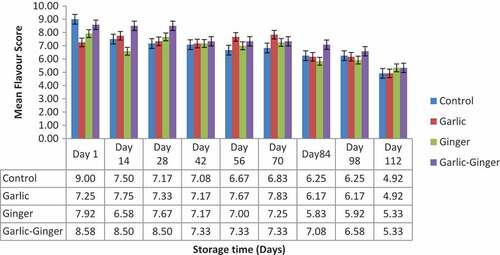
The result in indicates that taste panelists perceived the flavor of garlic–ginger homogenate to be the best when packaged inside nylon and stored at ambient for the 14th, 28th, 42nd, 56th, 84th, 98th, and 112th days as it had the mean score of 8.08, 8.25, 7.58, 7.75, 6.92, 6.58, and 6.00, respectively, while ginger-preserved catfish (with mean score of 7.58) was rated as having the best flavor on the 70th day of storage. Similar trend as observed in the flavor of unpackaged smoked fish where scores allotted by taste panelists for the flavor of smoked fish samples started reducing at the 98th day through 112 days was also observed when nylon was used as packaging material.
Figure 5. Effect of polythene as packaging materials on the flavor of differently preserved smoked catfish stored at ambient temperatures
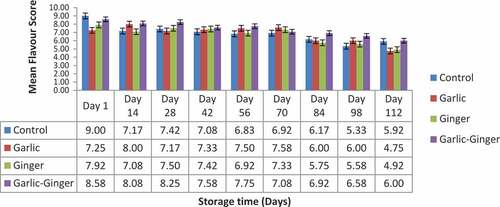
The result in also indicates that the garlic–ginger homogenate preserved catfish was rated to have the best flavor on the 14th, 28th, 42nd, 56th, 70th, 84th, and 98th days of storage when plastic (polyethylene terephthalate) was used as packaging material with the mean score of 8.73, 8.55, 8.36, 8.09, 7.73, 7.36, and 7.18, respectively. The flavor of the smoked catfish without preservatives was however rated as the best at the 112th day of storage when plastic was used as packaging material. The result also indicates that scores allotted by taste panelists for the flavor of smoked fish samples when nylon was used as packaging material started decreasing at the 98th day through 112 days of storage at ambient which was similar to the result obtained when the smoked fish samples were stored unpackaged and when they were packaged using nylon as packaging material.
Figure 6. Effect of polyethylene terephthalate as packaging materials on the flavor of differently preserved smoked catfish stored at ambient temperatures
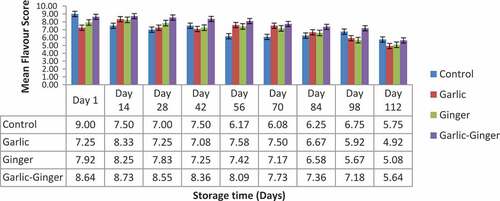
The result of the effect of different preservatives on the texture unpackaged smoked catfish stored at ambient temperatures as presented in indicates that unpreserved smoked catfish was rated as having the best texture immediately after smoking (with mean score of 8.25) and the 14th day of storage (with mean score of 8.08). However, garlic–ginger homogenate preserved catfish was rated as having the best texture on the 28th, 42nd, 56th, 70th, 84th, 98th, and 112th days of storage at ambient with mean score 7.83, 7.42, 7.50, 6.83, 6.75, 6.58, and 5.25, respectively. The result also indicates that the scores allotted by taste panelists for the texture of smoked fish samples started reducing from the 56th day of storage at ambient through 112 days when no packaging was used.
Figure 7. Effect of different preservatives on the texture of unpackaged smoked catfish stored at ambient temperatures
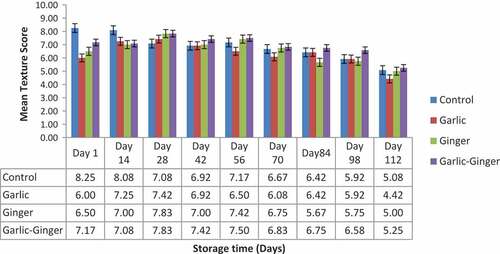
Similarly, the result in indicates that the texture smoked catfish preserved with garlic–ginger as was the best odor on the 14th, 84th, 98th, and 112th days of storage with mean score 8.24, 7.08, 6.75, and 4.29, respectively, when nylon (polyethylene terephthalate) was used as packaging material, while the ginger-preserved smoked catfish was rated as the best on the 28th, 56th, and 70th days of storage with mean score 7.50, 7.33, and 6.67, respectively, when packaged in nylon (polyethylene terephthalate). The result also indicates that the scores allotted by taste panelists for the texture of smoked fish samples started reducing from the 70th day through 112 days of storage when nylon was used as the packaging material with the exception of garlic–ginger homogenate preserved smoked catfish which score allotted started reducing after the 98th days of storage at ambient.
Figure 8. Effect of polythene as packaging materials on the texture of differently preserved smoked catfish stored at ambient temperatures
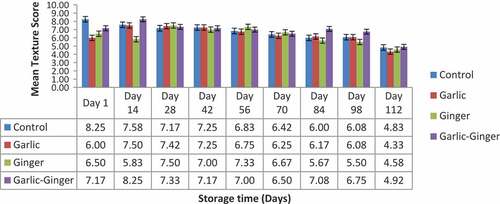
The result in also indicates that garlic–ginger homogenate preserved catfish was rated having the best texture at the 28th, 42nd, 56th, 84th, 98th, and 112th days of storage, respectively, with the mean score of 8.18, 7.82, 7.00, 7.00, and 5.18, respectively, when plastic (polyethylene terephthalate) was used as packaging material. However, ginger-preserved smoked catfish was rated best on the 56th and 70th days of storage (with mean values of 7.25 and 6.75, respectively), while garlic-preserved smoked catfish was rated having the best texture at the 14th day of storage (with mean value of 7.92) when plastic was used as the packaging material. The result also indicates that the scores allotted by taste panelists for the texture of smoked fish samples started reducing from the 84th day through 112 days of storage when plastic was used as the packaging material with the exception of garlic–ginger homogenate preserved smoked catfish whose allotted scores started reducing after the 98th days of storage at ambient.
Discussion
The result of this study indicates that garlic–ginger homogenate smoked catfish is the best preferred in terms of odor, flavor, and texture irrespective of the packaging material used for storage; it also took longer time before taste panelists also allotted lower scores to the odor and the texture of garlic–ginger homogenate smoked catfish during storage when compared with other spiced smoked catfish irrespective of the packaging material used. This suggests that smoked catfish can be glamorized by the addition of homogenized garlic–ginger rather than using either garlic or ginger alone, this will attract consumers’ attention and improve the market value of smoked fish.[Citation21] It is a very important marketing strategy to glamorize products in order to attract the consumer’s attention; Refs. [Citation11,Citation22] also opined that applying garlic and ginger to fish before smoking has beneficial effects on the overall quality of the final products such as improved taste, color, flavor, and general acceptance during storage.[Citation22] Smoked C. gariepinus samples treated with ginger were more acceptable by taste panelists than the untreated one.[Citation23] Food attributes are an important factor in predicting consumers’ perceptions in food choices decision.[Citation24] The study of food attributes indicated that the satisfaction levels of ethnic foods varies depending on diverse food attributes such as taste, fresh, colorful, uniqueness, and healthiness.
The superiority of plastic as a packaging material in retaining the sensory quality of smoked catfish over nylon was also established in this study as the result of this study also indicated that the taste panelists started allotting lower scores for the odor of unpackaged smoked catfish at the 56th day; they also started allotting lower scores for those packaged using nylon at the 70th day of storage at ambient, while they started allotting lower scores for those packaged using plastic after the 70th day of storage. Similar trend was observed in the texture of the smoked catfish as the taste panelists started allotting lower scores for the texture of unpackaged smoked catfish at the 56th day, while lower scores were allotted for those packaged using nylon at the 70th day of storage at ambient while they started allotting lower scores for the texture of smoked fish packaged using plastic at the 84th day of storage at ambient temperature. Plastic as a packaging material performs better function as a tool that protects and contains smoked fish product so that the environmental effect on smoked fish in the package is minimized in line with the opinion of Refs. [Citation25,Citation26]. Good packaging material will improve the storability of smoked dried fish by increasing the shelf life; this is better achieved by plastic as packaging material when compared with nylon. The observed general decrease in sensory quality of the smoked fish samples over time is similar to that observed by many authors like in Ref. [Citation8] who also observed general significant decrease in aroma, texture, and color in hot smoked rainbow trout (Oncorhynchus mykiss) that was packaged using different packaging materials during storage.
Conclusion
The study established that African mud catfish C. gariepinus is better spiced with garlic–ginger homogenate as the taste panelist preferred the odor, flavor, and texture of smoked garlic–ginger spiced smoked catfish than when garlic or ginger is used singly or when no preservative was added. It was also established that plastic (polyethylene terephthalate) is a better packaging material than polythene as the scores allotted by taste panelists started decreasing earlier for the odor and texture of the smoked fish samples with increased storage time when packaged inside nylon. It is thus recommended that garlic–ginger homogenate be used as both preservative and spices of C. gariepinus as it gives better odor, flavor, and texture than using only garlic or ginger; it is also recommended that plastic should be used as packaging material to package smoked catfish to improve its marketing on the shelves in super markets. This will lead to improvement of the value chain of fish, reduce impact damage on smoked fish, and provide additional business opportunity for investors as well as enhancing the export value of smoked fish.
References
- Ikenweiwe, N. B.; Bolaji, B. O.; Bola, G. A. Fabrication and Performance Assessment of a Locally Developed Fish Smoking Kiln. Ozean J. Appl. Sci. 2010, 3(4), 1–12.
- Otolowo, D. T.; Olapade, A. A. Influence of Processing Parameters on Microbial Load, Sensory Acceptability, and Mineral Contents of Dehydrated Catfish (Clariasgariepinus). J. Culinary Sci. Technol. 2018, 16(3), 209–223. DOI: 10.1080/15428052.2017.1363106.
- Oluwatoyin, D. K.; Stella, B. W.; Awujola, A. F. Indigenous Fish Processing and Preservation Practices Amongst Women in Southwestern Nigeria. Indian J. Tradit. Knowl. 2010, 9(4), 668–672.
- Ayeloja, A. A.; George, F. O. A.; Obasa, S. O.; Sanni, L. O. Effect of Post-Slaughter Time Intervals on the Quality of the African Catfish, Clarias Gariepinus (Burchell, 1822). Am. J. Food Technol. 2011, 6(9), 790–797. DOI: 10.3923/ajft.2011.790.797.
- Edah, B.; Bankole, N. O.; Akande, G. R.; Adeyemi, S.; Ayo-Olalusi, C. I. Organoleptic Characteristics, Length-Weight Relationship and Condition Factor of Oreochromis Niloticus in Egah River at Idah L.G.A of Kogi state, Nigeria. Int. J. Food Saf. 2010, 12, 62–70.
- Adeyeye, S. A. O.; Oyewole, O. B.; Obadina, O. A.; Omemu, A. M.; Adeniran, O. E.; Oyedele, H. A.; Olugbile, A.; Omoniyi, S. A. Effect of Smoking Methods on Quality and Safety of Traditional Smoked Fish from Lagos State, Nigeria. J. Culinary Sci. Technol. 2017, 15(1), 17–35. DOI: 10.1080/15428052.2016.1185072.
- Akinola, O. A.; Akinyemi, A. A.; Bolaji, B. O. Evaluation of Traditional and Solar Drying Systems Towards Enhancing Fish Storage and Preservation In Nigeria (Abeokuta LocalGovernment as a case study). J. Fish. Int. 2006, 1(2–4), 44–49.
- Khanipour, A. A.; Mirzakhani, N. Effect of Different Packaging Methods on Shelf Life of hot Smoked Rainbow Trout (Oncorhynchus mykiss) during Storage at 0–2ºC. Iran. J. Fish. Sci. 2013, 12(3), 620–628.
- Ayeloja, A. A.; George, F. O. A.; Akinyemi, A. A.; Atanda, O. O. Proximate and Mineral Composition Of Spiced Smoked Catfish Clarias gariepinus (Burchell, 1822). J. Agric. Sci. Environ. 2015, 15(2), 68–74.
- Cushnie, T. P.; Lamb, A. J. Antibacterial activity of flavonoids. Int. J. Antibacterial Agents. 2005, 343–356.
- Kumolu-Johnson, C. A.; Ndimele, P. E. Anti-Oxidative And Anti-Fungal Effect of Garlic (Allium sativum) Treatment on The Shelf Life of Hot-Smoked Catfish (Clarias gariepinus, Burchell 1822). World Appl. Sci. J. 2011, 13(7), 1628–1634.
- Onyeagba, R. A.; Ugbogu, O. C.; Okeke, C. U.; Iroakasi, O. Studies on The Antimicrobial Effects of Garlic (Allium Sativum Linn), Ginger (Zingiber officinale Roscoe) and Lime (Citrus aurantifolia Linn). Afr. J. Biotechnol. 2004, 3(10), 552–554. DOI: 10.5897/AJB.
- Oluborode, G. B.; Adelowo, E. O.; Unogwu, A. Processing and Packaging of Smoked Clarias Gariepinus In Niffr. Stand. Sci. Res. Essays. 2013, l2(2), 011–015.
- Siah, W. M.; Mohd, S. Effect of Different Packaging Materials on The Shelf Life of Modified Atmosphere Packaged Red Tilapia (Oreochromis mossambica) fillets. Int. Food Res. J. 2011, 18(3), 1091–1095.
- Abolagba, O. J.; Nuntah, J. N. Survey on Cured Fish Processing, Packaging, Distribution and Marketing in Edo and Delta States. J. Biotechnol. 2011, 2(5), 103–113.
- Trondsen, T.; Scholderer, J.; Lund, E.; Eggen, A. E. Perceived Barriers To Consumption of Fish Among Norwegian Women. J. Appetite. 2003, 41(3), 301–314.
- Roth, B.; Oines, S. Stunning and killing Of Edible Crabs (Cancer pagurus). J. Anim. Welf. 2010, 19(3), 287–294.
- Serkan, K.; Sevim, K.; Bekir, T. The Effect of Storage Temperature on The Chemical and sensorial Quality of Hot Smoked Atlantic Bonito (Sarda sarda, Bloch, 1838) packed in aluminium foil. Turk. J. Fish. Aquat. Sci. 2010, 10, 439–443.
- Tobor, T. G.; Fish Production and Processing on Nigeria. NIOMR Tech. Paper 1994. .
- Eyo, A. A.;. Fish Processing Technology In the Tropics; Published by University of Illorin Press: Nigeria, 2001.
- Abolagba, O. J.; Akise, O. G. Fish packaging in Benin, Edo State and Koko, Delta State. Aust. J. Basic Appl. Sci. 2011, 5(12), 189–195.
- Idris, G. L.; Omojowo, F. S.; Omojasola, P. F.; Adetunji, C. O.; Ngwu, E. O. The Effect of Different Concentrations of Ginger on The Quality of smoked Dried Catfish (Clarias gariepinus). J. Nat. Sci. 2010, 8(4), 59–63.
- Kwangho, L.; A.study of perceived attributes of Asian foods: Comparison of implicit and explicit attitude measures. A Master of Science Thesis presented to the Faculty of the Graduate School University of Missouri. 2010, 103.
- Jang, S. S. C.; Ha, A.; Silkes, C. A. Perceived Attributes of Asian Foods: From The Perspective of The American Customers. Int. J. Hospitality Manage. 2009, 28(1), 63–70. DOI: 10.1016/j.ijhm.2008.03.007.
- Naser, K.; Razzagh, M.; Babak, P. Effect of Packaging Material on Color Properties of Catsup Tomato Sauce. J. Appl. Packag. Res. 2018, 1, 10–16.
- Folorunsho, O.; Michael, O.; Olufemi, P. Development of Appropriate Packaging For Shelf Life Extension of smoked Fish In a Developing Economy. Int. J. Fish. Aquat. Stud. 2015, 2(4), 46–50.

